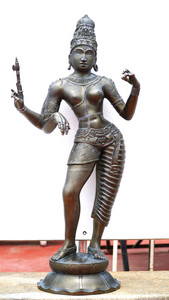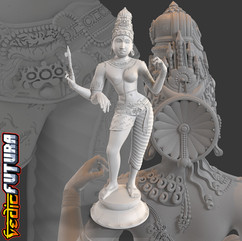tldr:The Ardhanarishvara bronze in the Chennai Museum is a remarkable convergence of art, philosophy, and cultural expression. It represents not just the divine unity of Shiva and Parvati but also the broader themes of balance, inclusivity, and harmony that transcend time and place. Its exquisite craftsmanship, profound symbolism, and social relevance ensure its enduring legacy as a masterpiece of Indian art.
Through our 3D recreation, we aim to honor this legacy and make it accessible to a global audience. The Ardhanarishvara stands as a reminder that opposites are not antagonistic but complementary, offering a timeless lesson in unity and coexistence.

Ardhanarishvara: Philosophy, Social Relevance, and the Timeless Artistry of the Chola Bronze at the Chennai Museum
The Ardhanarishvara, or “Lord Who is Half Woman,” stands as a profound symbol of the integration of masculine and feminine energies in Indian philosophy and art. This composite deity, combining the forms of Shiva and Parvati, is not merely a visual representation of unity but also a profound embodiment of cosmic balance. Among the many representations of Ardhanarishvara across India, the exquisite bronze housed in the Government Museum, Chennai, is a masterpiece of Chola artistry. This article explores the philosophical significance, socio-cultural connotations, and extraordinary artistic merit of this sculpture, while providing a detailed description of its form.
The Philosophical Significance of Ardhanarishvara
The Ardhanarishvara form embodies a profound synthesis of Purusha (the passive, masculine principle) and Prakriti (the active, feminine principle), foundational concepts in Hindu philosophy. This union signifies that the universe’s creation and balance arise from the harmonious interplay of these dual forces. In this depiction, Shiva represents consciousness and stillness, while Parvati embodies energy and dynamism. Their amalgamation in Ardhanarishvara conveys the message that opposites are not in conflict but are complementary forces essential for cosmic harmony.
The concept of Ardhanarishvara is deeply rooted in Hindu mythology and philosophy. Texts like the Skanda Purana and the Shiva Purana narrate the origins of this form, emphasizing the unity and equality of male and female principles. The depiction serves as a reminder that divinity transcends gender distinctions, presenting a holistic view of existence.
In tantric traditions, Ardhanarishvara holds significant symbolic importance. The male side represents the pingala nadi (solar energy) in the body, while the female side corresponds to the ida nadi (lunar energy). Their equilibrium is believed to awaken the kundalini, the dormant spiritual energy within. This balance is essential for spiritual awakening and enlightenment, underscoring the Ardhanarishvara’s importance in spiritual practices.
The Ardhanarishvara’s portrayal of duality transcends gender roles and norms. It embodies a metaphysical truth, showing that opposites are interdependent and that their union sustains the universe. This depiction challenges traditional binary views of gender by illustrating that both masculine and feminine aspects coexist harmoniously within one divine figure.
The Socio-Cultural Implications of Ardhanarishvara
The Ardhanarishvara form has far-reaching social connotations. In a patriarchal society, it offers a powerful reminder of the interdependence of men and women. By depicting the divine as both male and female, the sculpture challenges rigid gender roles and emphasizes the equality and complementarity of masculine and feminine forces. This perspective aligns with Indian philosophical traditions, which often ascribe dynamism and activity to the feminine principle (Shakti), while associating consciousness and stillness with the masculine principle (Shiva).
During the Chola period (9th–13th centuries CE), this depiction would have resonated strongly with societal ideals. The Ardhanarishvara not only reflected cosmic truths but also served as a subtle reminder of the balance required in human relationships, social structures, and spiritual practices. In modern contexts, this form continues to inspire discussions about gender inclusivity, fluidity, and the breaking of binary norms.
Description of the Ardhanarishvara Sculpture in Chennai Museum
The Ardhanarishvara bronze at the Government Museum in Chennai, dated to the 11th century CE, is a quintessential example of Chola artistry. Originating from Tiruvenkadu in Tamil Nadu, the sculpture stands at a height of 101 cm and embodies the technical mastery and spiritual vision of the Chola artisans.
The Overall Composition
The statue depicts the divine figure in a balanced and harmonious stance. The body is divided vertically, with the right half representing Shiva and the left half representing Parvati. Despite the division, the sculpture achieves a seamless flow, symbolizing the unity of opposites. The posture, a gentle tribhanga (three-bend pose), imparts a sense of dynamism and grace, as though the figure is caught mid-dance. This fluidity is a hallmark of Chola bronzes, which were designed to evoke both physical vitality and spiritual transcendence.
The Right Half: Shiva
On the right side of the sculpture, Shiva is depicted with a muscular physique, exuding strength and stability. His head is adorned with a jatamakuta (matted hair), complete with the crescent moon and a detailed depiction of the Ganga river descending from his locks. His upper right hand holds a small axe (parashu), a symbol of his role as a destroyer of evil and ignorance. The lower right hand rests gracefully on the back of Nandi, the bull, which serves as Shiva’s vehicle and symbolizes dharma (righteousness).
The male torso is bare, emphasizing Shiva’s ascetic nature. The garments are minimal, with a short lower cloth tied around the waist. The ornamentation is restrained but finely detailed, including armlets, bracelets, and a sacred thread (yajnopavita) draped diagonally across the chest.
The Left Half: Parvati
The left half of the sculpture contrasts with Shiva’s austerity, embodying the elegance and sensuality of Parvati. Her form is softer, with a rounded hip and a gently curved torso. The head is adorned with a karandamakuta (conical crown), intricately carved to reflect Parvati’s regal and divine nature. Her upper left hand is raised in a graceful gesture, perhaps holding a lotus, symbolizing purity and beauty. The lower left hand rests near the waist, emphasizing the femininity of her posture.
Parvati’s torso is adorned with a profusion of jewelry, including necklaces, earrings, and bangles, reflecting the abundance and prosperity associated with the goddess. Her drapery, extending to the anklets, is rendered with delicate folds, showcasing the artisans’ skill in capturing the texture and flow of fabric.
The Face and Expression
The face of Ardhanarishvara is a masterpiece of synthesis. It combines the strength of Shiva with the softness of Parvati, creating an androgynous visage that transcends gender. The eyes are half-closed, evoking a meditative state, while the slight smile conveys a sense of divine serenity. The symmetry of the features reinforces the underlying message of unity, making the figure both approachable and awe-inspiring.
Every element of the sculpture carries deep symbolic meaning. The axe represents the destruction of ignorance, while the lotus signifies spiritual awakening. The juxtaposition of Shiva’s austerity with Parvati’s opulence highlights the balance of renunciation and enjoyment, a recurring theme in Hindu philosophy. Even the bull Nandi, often depicted as gazing upwards, underscores the devotee’s yearning for divine grace.
The Artistic Merit of the Chola Ardhanarishvara
The Chola bronze Ardhanarishvara is not merely a representation of divine philosophy; it is a testament to the artistic brilliance of its creators. The sculpture was crafted using the lost-wax casting technique (cire perdue), a method that allowed for intricate detailing and lifelike expressions. The process involved creating a wax model, encasing it in clay, and replacing the wax with molten bronze. Once the mold was broken, the artisans meticulously refined and polished the figure, achieving a level of detail that is unparalleled.
The dynamic posture, realistic anatomy, and intricate ornamentation showcase the Chola sculptors’ deep understanding of both human and divine forms. The ability to balance the contrasting elements of masculinity and femininity within a single figure reflects their philosophical insight as much as their technical skill. The sculpture’s rhythm and vitality make it appear almost alive, inviting the viewer into a direct encounter with the divine.
A Modern Recreation: Making the Ardhanarishvara Accessible
Life-Size 3D Printed version
In an effort to preserve and share this cultural heritage, we have meticulously recreated the c statue in 3D. This digital model faithfully captures the intricate details and proportions of the original, allowing enthusiasts, researchers, and students worldwide to study its artistic and philosophical significance.



Renders of VF recreation of Ardhanarishvara
The 3D printable version of the statue is available for download at popular 3D printing repositories, for free. This initiative aims to make this iconic masterpiece accessible to a broader audience, offering a unique opportunity to own a piece of history and engage with the legacy of the Chola artisans. You can also watch the whole process of sculpting, 3D printing and assembly here, on our YouTube Channel
Download Links:















